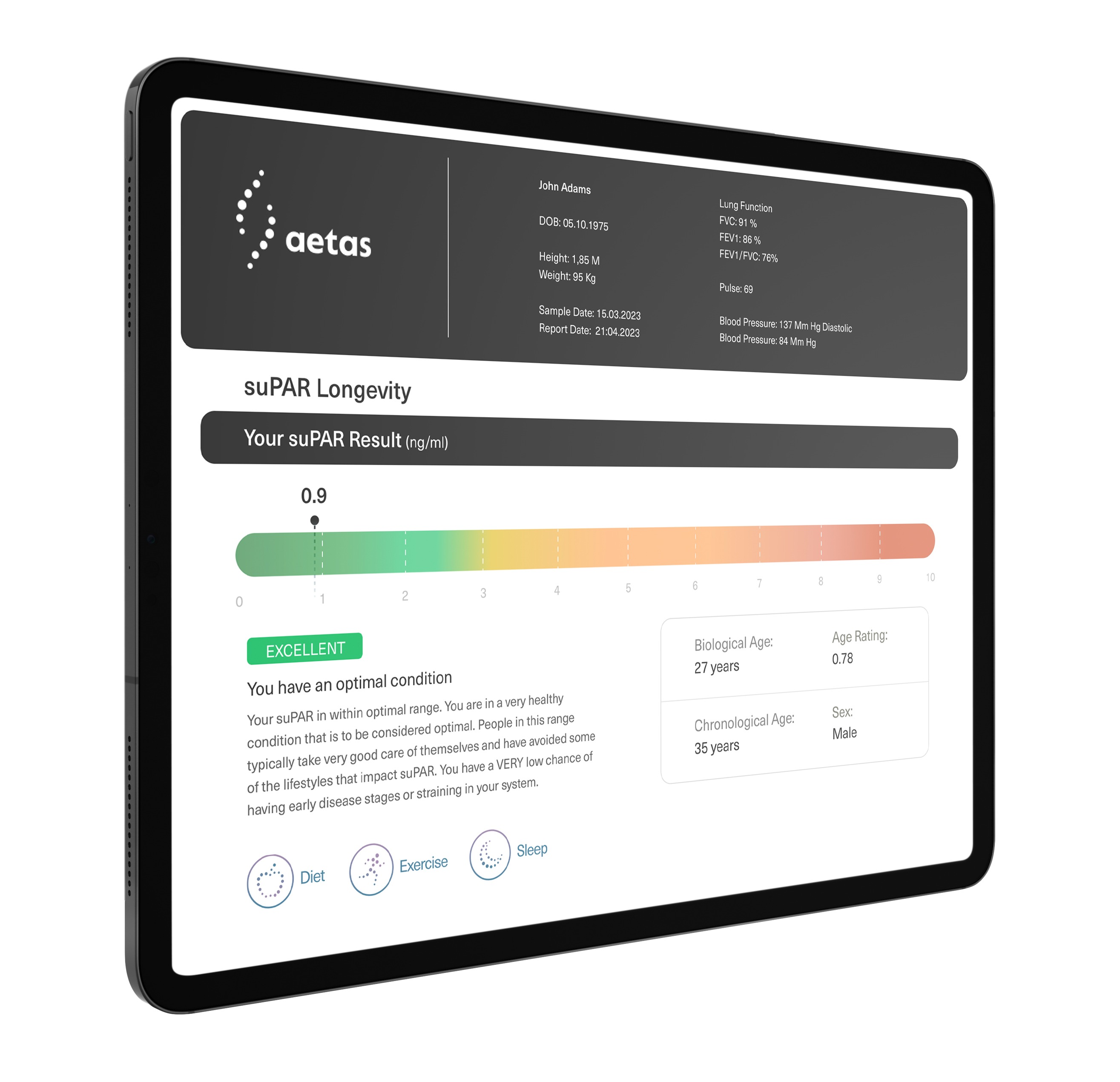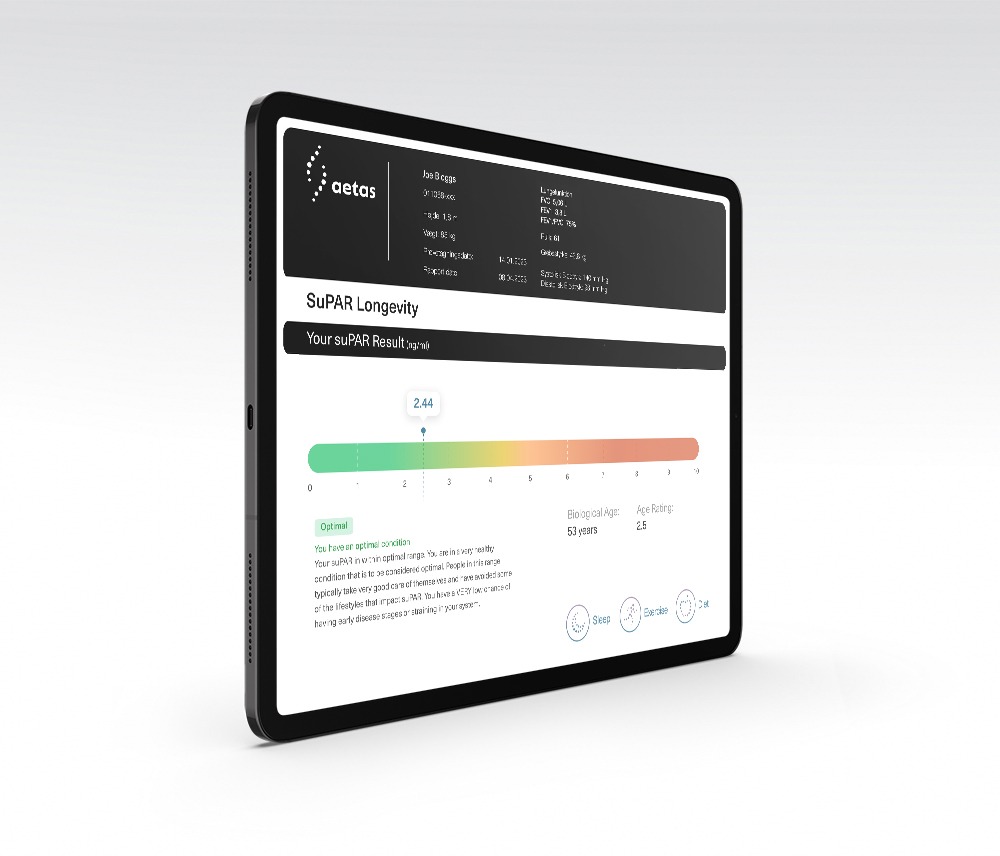Inflammation is at the root of practically all known chronic health conditions.
suPAR Health is a precision biomarker that accurately detects your current levels of otherwise invisible background inflammation, giving you precise prognostic intel of the state of your current and future health.

Monitor your health performance
Effectively monitoring your health performance is crucial for your well-being. The suPAR Health test serves as a valuable preventive tool, assessing your risk of developing serious diseases over the next 10 years. Regardless of the test results, gaining a comprehensive understanding of your health empowers you to protect it consciously and fine-tune your health efforts, through diet, exercise, sleep, and other Longevity interventions.
With Aetas cutting-edge suPAR Health test, you can monitor if what you are doing really works for improved quality of life. Used correctly, the test provides valuable information about your current health status, effect of intervention and upcoming disease risk. A low score indicates that your health is in good shape and that your lifestyle is well-tolerated by your body. This encourages you to continue your intervention and actions.
Conversely, a high suPAR score presents an opportunity to proactively identify the underlying causes at an earlier stage. It allows you to step up your health game and implement personalized Longevity protocols, such as dietary adjustments, exercise, optimized sleep, and targeted supplements. These measures are aimed at keeping illness at bay for as long as possible, emphasizing the importance of intervention and proactive care.
Trusted by Hospitals across the World
The suPAR biomarker has been making a difference in the healthcare system for over 20 years, by providing medical personnel in hospitals with information that empowers them to save lives and provide patients with the treatment they need.
Backed by Scientific studies
There are more than 1.000+ clinical studies published on suPAR, substantiating it as one of the most promising prognostic biomarkers across diseases in the world. Furthermore, the suPAR assay has been approved for all major clinical chemistry analyzers.
Know your health, properly
Consistent testing helps us understand how your body responds and heals over time. The Aetas protocols are designed around reducing inflammation in your body and perpetually limiting the aging process. We recommend getting tested every 3 months.

Calculate your biological age with your suPAR result
suPAR Health - Biological age
WHAT IS YOUR GENDER?

“Every man has two lives, and the second starts when he realises he has just one”
Confucius
Ancient Chinese Philosopher
The philosophy behind preventive medicine is to avoid pathologic consequence by early disease detection. The suPAR Health test is fast, precise & affordable, making it a groundbreaking prognostic tool for Longevity.
Prices shown in

suPAR Health Test
suPAR Health is a precision biomarker that accurately detects your current levels of otherwise invisible background inflammation, giving you precise prognostic intel of the state of your current and future health.
Prices starting from
Package Includes
Frequently Asked Questions
The suPAR Health test serves as a valuable tool for predicting the likelihood of developing an illness. Taking this test can provide insight into the presence of potentially serious diseases that may manifest within the next 10 years1,Eugen-Olsen, J., Andersen, O., Linneberg, A., Ladelund, S., Hansen, T. W., Langkilde, A., Petersen, J., Pielak, T., Møller, L. N., Jeppesen, J., Lyngbaek, S., Fenger, M., Olsen, M. H., Hildebrandt, P. R., Borch-Johnsen, K., Jørgensen, T., & Haugaard, S. B. (2010). Circulating soluble urokinase plasminogen activator receptor predicts cancer, cardiovascular disease, diabetes and mortality in the general population. Journal of internal medicine, 268(3), 296–308.2Hayek, S. S., Sever, S., Ko, Y. A., Trachtman, H., Awad, M., Wadhwani, S., Altintas, M. M., Wei, C., Hotton, A. L., French, A. L., Sperling, L. S., Lerakis, S., Quyyumi, A. A., & Reiser, J. (2015). Soluble Urokinase Receptor and Chronic Kidney Disease. The New England journal of medicine, 373(20), 1916–1925..
A high suPAR score indicates the existence of an underlying significant factor. However, this circumstance presents an advantageous opportunity to identify the root cause at an earlier stage, ultimately leading to the potential prevention of disease.
Conversely, a low suPAR score in the test implies a positive state of health and suggests that your body can “tolerate your lifestyle” without any immediate concerns.
At our Longevity clinic in Hellerup, we draw your blood with a simple minimal invasive blod test. The procedure only takes a few minutes, and you get your test result within a few days.
The suPAR Health test costs 950 DKK. When you purchase one of our larger health examinations, Health Check, Health Baseline, or Health Intelligence, a suPAR test is included in the price. Since the test is designed to be taken over time repeatedly, we created a 10 x SuPar Health test package at a 30% discount.
We recommend that you take a suPAR Health test once every 3-6 months to keep an eye on your immune system’s activity and to have something to compare your levels to in the long run.
Smokers can lower their suPAR by an average of 1.0 ng/ml by quitting smoking. The result can already be measured after 4 weeks3Eugen-Olsen, J., Ladelund, S., & Sørensen, L. T. (2016). Plasma suPAR is lowered by smoking cessation: a randomized controlled study. European journal of clinical investigation, 46(4), 305–311..
Less active people can lower their suPAR by 0.4 ng/ml by increasing the frequency of their exercise protocols. Individuals with a BMI of 35+ can lower suPAR by 0.5 ng/ml by losing weight.
Individuals who regularly eat unhealthy food can lower their suPAR by 0.3 ng/ml by switching to a healthy diet4Haupt, T. H., Kallemose, T., Ladelund, S., Rasmussen, L. J., Thorball, C. W., Andersen, O., Pisinger, C., & Eugen-Olsen, J. (2014). Risk factors associated with serum levels of the inflammatory biomarker soluble urokinase plasminogen activator receptor in a general population. Biomarker insights, 9, 91–100..
People who suffer from bad sleep, can reduce their suPAR levels significantly by adjusting their sleep rhythm and sticking to a consistent sleep cycle.
Stressed people can reduce their suPAR levels by 0.3 ng/ml by taking proactive measures to remove the stressful factors from their everyday lives.
The association between alcohol consumption and suPAR is not completely clear, but alcoholic liver disease causes very high suPAR levels5Sjöwall, C., Martinsson, K., Cardell, K., Ekstedt, M., & Kechagias, S. (2015). Soluble urokinase plasminogen activator receptor levels are associated with severity of fibrosis in nonalcoholic fatty liver disease. Translational research: the journal of laboratory and clinical medicine, 165(6), 658–666..
If you reduce your suPAR level, you automatically reduce your suPAR biological age as well, as the two are interconnected. To reduce it, the same health interventions apply as for reducing suPAR.
The suPAR Health test reveals your biological age and the rate at which you are aging. Generally speaking, people with high suPAR age at a faster rate than normal (e.g. 1.4 years per year), while those with low suPAR age at a slower rate (e.g. 0.75 years per year). These people have actually managed to slow down their aging process6Rasmussen, L. J. H., Caspi, A., Ambler, A., Danese, A., Elliott, M., Eugen-Olsen, J., Hariri, A. R., Harrington, H., Houts, R., Poulton, R., Ramrakha, S., Sugden, K., Williams, B., & Moffitt, T. E. (2021). Association Between Elevated suPAR, a New Biomarker of Inflammation, and Accelerated Aging. The journals of gerontology. Series A, Biological sciences and medical sciences, 76(2), 318–327..
Inflammation is your body’s biological response either to the presence of foreign substances (bacteria, viruses, toxins, etc.) or to injury. It is your body’s way of protecting itself by creating an area of increased blood flow to the affected area, allowing the immune system to begin healing quickly.
Acute inflammation is a short-term response to an injury or infection that involves your body’s immune system. This could be a sprained ankle or a common virus infection and usually lasts for a few days with signs and symptoms like localized redness, swelling, warmth, headaches, muscle pain, etc.
Chronic inflammation, on the other hand, is what happens when the acute inflammation can not resolve the situation. The body’s immune system does not turn off after the initial response and instead of healing, the inflammation will stay in your body for weeks, months – or even years. The signs of chronic inflammation are often ‘invisible’, as they are spread throughout the body and harder to localize. As a result, this type of inflammation is harder to resolve and detect, and thus more dangerous as it may lead to cardiovascular disease, autoimmune disorders, cancer and neurological disease.
Chronic inflammation and a high suPAR level are often caused by lifestyle factors such as poor diet, smoking, and lack of exercise7Rasmussen, L. J. H., Petersen, J. E. V., & Eugen-Olsen, J. (2021). Soluble Urokinase Plasminogen Activator Receptor (suPAR) as a Biomarker of Systemic Chronic Inflammation. Frontiers in immunology, 12, 780641., and can be exacerbated by environmental factors such as pollutants8Fagerberg, B., Borné, Y., Barregard, L., Sallsten, G., Forsgard, N., Hedblad, B., Persson, M., & Engström, G. (2017). Cadmium exposure is associated with soluble urokinase plasminogen activator receptor, a circulating marker of inflammation and future cardiovascular disease. Environmental research, 152, 185–191. and allergens. A healthier lifestyle can lead to a lower suPAR level, which requires adjusting known lifestyle factors such as smoking, alcohol, sleep, diet, exercise9Haupt, T. H., Rasmussen, L. J. H., Kallemose, T., Ladelund, S., Andersen, O., Pisinger, C., & Eugen-Olsen, J. (2019). Healthy lifestyles reduce suPAR and mortality in a Danish general population study. Immunity & ageing : I & A, 16, 1., and stress10Bourassa, K. J., Rasmussen, L. J. H., Danese, A., Eugen-Olsen, J., Harrington, H., Houts, R., Poulton, R., Ramrakha, S., Sugden, K., Williams, B., Moffitt, T. E., & Caspi, A. (2021). Linking stressful life events and chronic inflammation using suPAR (soluble urokinase plasminogen activator receptor). Brain, behavior, and immunity, 97, 79–88..
suPAR was discovered by Danish researcher and biochemist Jesper Eugen-Olsen, who is part of the Scientific advisory board of Aetas Diagnostics. Back in 1999, he demonstrated a link between the level of suPAR protein in the blood and the activity of HIV patients’ immune systems11Sidenius, N., Sier, C. F., Ullum, H., Pedersen, B. K., Lepri, A. C., Blasi, F., & Eugen-Olsen, J. (2000). Serum level of soluble urokinase-type plasminogen activator receptor is a strong and independent predictor of survival in human immunodeficiency virus infection. Blood, 96(13), 4091–4095.. Since then, he has founded the company ViroGates, which has developed and patented the suPAR test.
LITERATURE REFERENCES
